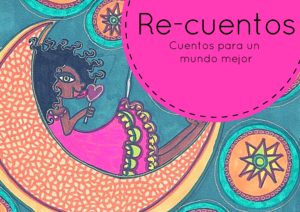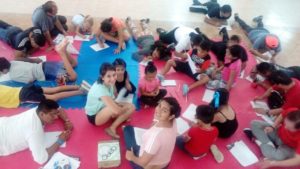Stories are powerful. They reflect what we socially consider good, valuable, and desirable. As we encounter them from a young age, stories inevitably influence our social imaginaries – that is, our worldviews, values and practices – by providing us with frames of reference and meaning. However, as stories produce and reproduce socially accepted values and expectations, they can come to function as a site for the reproduction of hegemonic norms.
Being a member of No Somos Medias Naranjas, a voluntary feminist organisation – what in Spanish we call colectivo – that seeks to raise awareness and prevent gender-based-violence in Mexico, I have come to identify, with dismay, the intimate relationship there seems to be between gender inequality and traditional storytelling. It seems that our most common children stories have often failed to provide girls, and us women, with creative possibilities that expand our understanding and expectations of ourselves. Instead, they have promoted an adherence to traditional gender roles and the uneven power relations that they may support. The most obvious example is of course the traditional fairy tale where the female character, a princess, despite being usually the central character is mostly silent – passively waiting to be rescued – and seems to have one purpose in life, to find a partner who can provide the happiness she has been longing for. These stories have also failed to provide boys, and men, with a wider notion of masculinity. They tend to promote a masculine identity based on the fulfilment of the “provider role” vis-à-vis women, most of which is regarding security whether physical, economic or emotional – what is usually comprised in the “happily ever after”. As such, these stories tend to promote a model of masculinity anchored in asymmetric gender relations, where men are powerful and women powerless.
The presence of gendered imaginaries in these stories and their production and reproduction of gender inequality can also translate, worryingly, into risk of gender-based violence for women. Traditional stories teach a love discourse that may be downplaying gender-based-violence at times. As they teach we always have the capacity of changing someone for good and that romantic love is one of our most important achievements as women, they might increase our willingness to make sacrifices in the name of love. Moreover, they may be reinforcing a toxic notion of masculinity, where emotions are channelled through acts of violence rather than expression. After all, when have we seen a male character in these stories cry? Lastly, it seems to me that these stories have also undermined the notion and importance of female solidarity – or sisterhood. When have we seen in these stories powerful examples of girls or women working together to solve a problem? Until recently, the most frequent (and perhaps the sole) relationship depicted in these stories between women was that of competition and rivalry. As such, these stories may well be also crippling our ability to come together, support each other, politicise our experiences and organise against gender inequality and gender-based violence.
Being an avid reader and a feminist, storytelling emerged to me then as a site of struggle. Children stories, until now, may have tended to produce and reproduce gender inequality, but there is no reason why they should remain unchallenged. If storytelling has been sequestered by, and complicit in, patriarchy, feminism needs to turn its attention to it. This was the aim of my project called Re-cuentos, cuentos para un mundo mejor, undertaken as my pro-bono project in the Weidenfeld Hoffmann Leadership Programme.
The project was developed in collaboration with Karla González Pech, a terrific young writer and a dear friend of mine. It comprised a collection of ten short stories, some of them translations from their original versions in English, some of them amending classic stories such as The Beauty and the Beast, and some of them of our entire own creation. Our stories seek to challenge gender roles by providing a wider range of role models for both of girls and boys, promote sisterhood between girls and offer alternative love discourses that may contribute to the prevention of gender-based violence.
Re-cuentos was implemented in the city of Merida in Mexico in the months of August and September 2017. We designed the project with Mexico in mind, partly because we are both Mexican women and are deeply invested in seeing the situation for girls and women improve in our country, and partly because we saw here an absence of new narratives for children. Whereas in other parts of the world, especially English-speaking ones, new storybooks with the explicit goal of promoting gender equality are emerging, there are few of the kind available in Spanish in Mexico and even less at a reasonable price.
The community centre Ricardo López Méndez, Dante bookshops and Plaza Dorada mall supported our initiative and gave us the space and time to share our stories with children. As these spaces required different dynamics, our sessions were designed in two modalities. In the community centre, where we were given a weekly one-hour space for a total of four weeks, our sessions comprised the reading of three short stories, each followed by a crafty activity meant to open a space for self-reflection and dialogue about the story’s main message. For example, our story titled Las pociones de Dragoncia (Dragoncia’s Potions in English), about a little female dragon who embarked on an adventure to discover a potion for self-love, was followed by an activity where each girl and boy were prompted to create their own self-love potion recipe incorporating the things that contribute to their wellbeing on top of the classic nasty potion-like ingredients. In the bookshop and mall, where we were given two slots of three to four hours during which we would invite people coming in the store or the mall to join us for a brief moment, our fifteen-minute sessions comprised the reading of two short stories with the use of props, such as character figures and paper backgrounds. Overall, our project reached around 150 children.
Spending all this time with children strengthened my belief in the importance of storytelling. I saw surprise in their eyes when a story introduced an unexpected turn, such as a princess who rescued a prince or a boy who learned to value difference, and I also saw excitement when the story opened new possibilities in their imagination. Perhaps, the impact of the project is captured in the words of one little girl who told me during an activity that asked them to come up with alternative endings to Disney stories: “in my version of the Little Mermaid, Prince Eric transforms into a merman to marry Ariel and accompany her as Queen of the Ocean”.
Stories enable new ways of thinking about, and approaching, the world and ourselves. If our aim is gender equality, our stories – embodying and transmitting of norms and values – need to be (re)imagined and (re)told accordingly. For this, feminism needs to continue engaging with storytelling.





